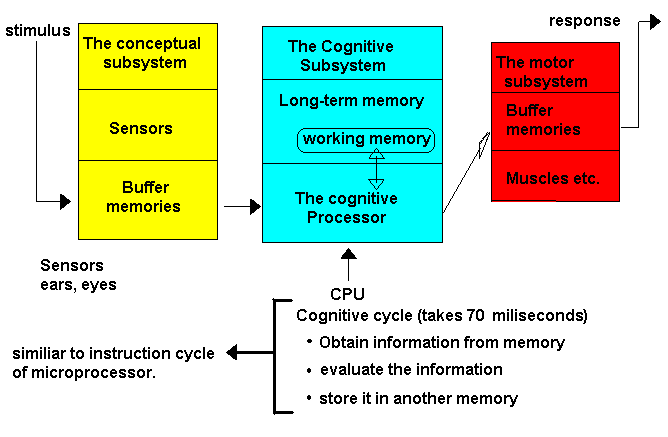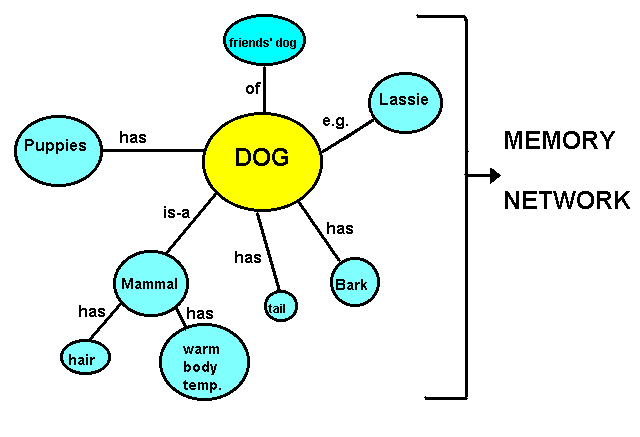![]()
Chapter 5 Knowledge Acquisition
![]()
The reasons why productivity is so poor include the following:
We shall consider how people solve problems. Human problem solving is used as a model by AI researchers and most knowledge engineers are well versed in cognitive psychology.
5.3.1 Human Information Processing
A person's cognitive behaviour is best desribed in the same way that we describe information processing in a computer.
This is not to suggest that people are computers.Biological systems are very different from existing computer systems.
But focusing on the question of how people process information, psychologists are able to describe the specific strategies people use to encode, store and, recal information.

In the simplest tasks, the cognitive subsystem serves as a point for transferring (passing) information from sensory inputs to motor outputs. Habitual tasks such as reaching out to hold a cup of tea are like that. There is no "deep thought". In fact, the "thinking" that occurs during such an action is impossible to recover.Just try to explain someone how you hold the handle of the cup.
Long-Term Memory : consists of a large number of stored symbols with a complex indexing system.
There are hypotheses about what the (elementary) symbols are & how they are organized in the memory.
Memory consists of clusters of symbols called "chunks". A chunk is a symbol associated with a set of stimuli.

Memory is thought to be a huge network of chunks.
Learning and remembering occur as linkages between chunks are established
and revised.
A human can store 4 to 7 chunks in his or her SHORT TERM MEMORY at the same time. Conceptualize this as a computer screen with a number of flash-up windows. In one window yo have a memo you are composing in another looking at a spreadsheet.
Time is needed to add new chunks of information to long-term memory (around 10 years depending on the information-stuff that is learnt now will probably not mature until the 30s-.) Altough storage takes a relatively long period of time, the human information processing system can access LONG TERM MEMORY relatively quickly-once in each 70 milliseconds. No known limit to the amount of information that can be stored in Long Term Memory.
PROBLEM SOLVING : is finding a way to get from some initial
S -> S situation to a desired goal.
E.g. how to get to home from the university.
i g
As the computer takes over more programmable functions, human thinking and problem solving is shifting to nonprogrammable activities. These include activities involving imagination, attitude, emotion and humour.
While programmables include sequential, step-by-step algorithms, for effective problem solving we have to do a few things:
This is the essence of creative and productive thinking and problem solving for that matter.
Creative people have positive attitude toward problem solving.
We have just mentioned that we must develop certain attitudes and tools. In fact, these are the "heuristics".
Heuristics can help us in 3 basic areas:
Knowledge Acquisition involves learning, memory & representation and transfer of knowledge.
In order to acquire knowledge we need active involvement,
Advice: Be active.
For instance, I learn a subject when I teach. Teaching is active mode of learning rather than passive.
In the absence of an oppurtinity to teach, for instance you study for expert systems exam, close the book periodically, and become an active learner by writing a brief summary. This is better than the passive approach of re-reading the material and highlighing it in various colors with a phosphorus pen.
When you wish to memorise something, try to produce an acronym.
ACRONYMS can be viewed as indices for storage and retrieval.
For example, to memorise the names of great lakes in the North American continent one can use the acronym below:
H O M E S --------> Huron, Ontario, Michigan, Erie, Superior
If you are jewish and have a name called MOSHE perhaps you'd use that rather than HOMES.
Stories and concrete examples can serve as repositories of knowledge
that we can transfer to new situations. That is why so often, while trying
to solve a problem, we might say, "The situation is such and such, which
reminds me of story...". So, stories are compact storage chunks.
programs".
This was knowledge acquisition heuristics.
Now, heuristics for problem representation.
A common error in approaching problems is to move into problem soving
mode too soon.
We have to allow sufficient time for representation.First GET the
FACTS!
Imagine while driving a lorry on a motorway you approach a bridge. A
sign informs you that the clearance is 4m.45 cm. However, your lorry is
4.5 m high. What are you going to do? Let's see the creative ones among
you. Most people say deflate the tyres. Anyone would proceed to do so would
be moving to soon into problem solving mode.
Stop first, get out of lorry, inspect bridge, try to measure the height,
there is no problem.